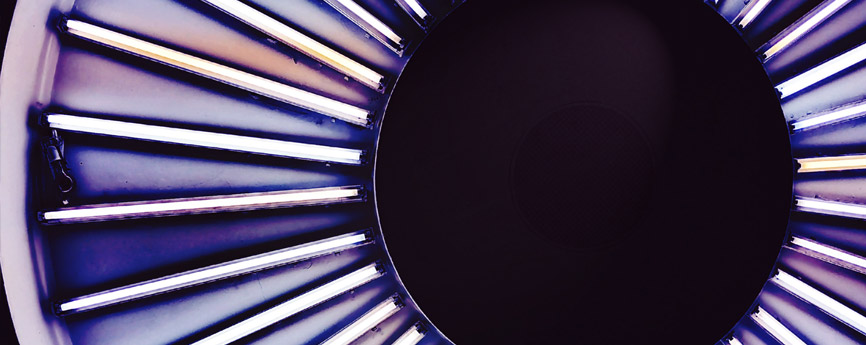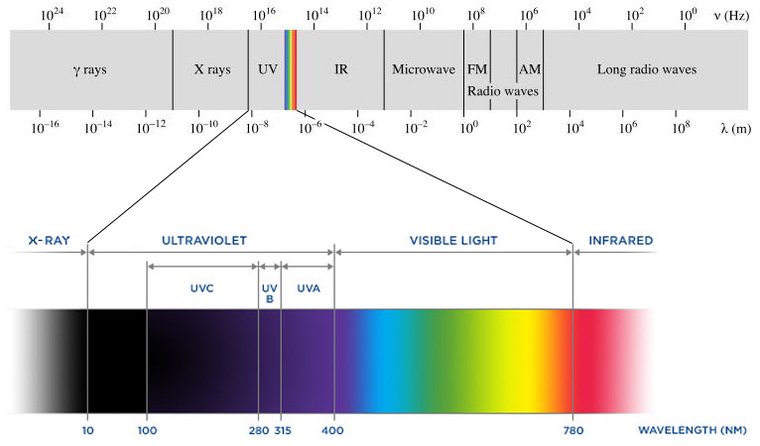Ultraviolet C light: analysing the pros and cons of this technology
[

]
The pandemic has impacted almost every aspect of our day-to-day lives. However, it has also made us question the safety and effectiveness of our disinfection habits. One of the methods that has sparked controversy is disinfection with UV-C light.
What is UV-C light?
UV-C light is invisible to the human eye. Why? This is because its position in the electromagnetic spectrum is between X-rays and visible light, that is, what our eyes can perceive.
When we hear “UV rays”, we immediately think of the sun’s radiation, don’t we? In reality, the sun’s rays that can cause so much damage to our skin are made up of UV-A (longwave) and UV-B (mediumwave) rays. They are the big brothers, so to speak, of UV-C light. This is a shortwave light that has more energy than the others, but also a shorter range.
The germicidal properties of UV-C light are due to its wavelength forming covalent bonds that intercept the genetic sequence of microorganisms. In this way, it “deactivates” the DNA of viruses and bacteria, making it impossible for them to reproduce. Once the microorganism is unable to reproduce, it is no longer infectious.
What are its drawbacks?
As humans, this technology sounds great, until the question arises, can it affect us too? Here is the answer.
The Scientific Committee on Health, the Environment and Emerging Risks ruled in 2016 that if there is “accidental acute exposure” to high levels of UV radiation emitted by UV-C lamps, it is possible to damage eye and skin tissue. To this end, strict safety protocols during the disinfection process have been implemented. These include; the lamps have special containers and the people responsible for the application are specialists and have radiation-proof equipment.
Regarding this technology, another drawback could be that the disinfection is only effective if the UV-C light directly hits the microorganisms, and it can be blocked by objects in its path. To minimize this risk, lamps have been manufactured that have UV-C lightbulbs at different angles, which allows for 360º cover.
What are its benefits?
One of its most beneficial attributes is its speed. The process is quite fast, however, the duration of the disinfection is linked to the size of the surface to be sterilised. In experiments, it has been demonstrated that with only two minutes of exposure to ultraviolet C rays, bacteria such as e-coli have lost the ability to reproduce.
Unlike other methods such as fumigation, disinfection with ultraviolet light does not require any kinds of chemical agents. So it does not leave harmful or annoying residues in the environment to be disinfected. This makes it a simple and safe method.
Finally, one of the greatest points in its favour is that it can be applied to a wide variety of pathogens, and has been shown to be equally effective. It has even been shown that this method can deactivate bacteria that have mutated, becoming resistant to medication.
As we can see, this method has both arguments in its favour, and reasons to be cautious about its use. The most important thing to remember is that it must be applied responsibly, following the safety methods to minimize its risk significantly so its benefits can be enjoyed without needing to worry.
Bibliography
BBC News. (2020). Coronavirus: qué es la luz UVC que se utiliza para desinfectar superficies (y qué riesgos conlleva). BBC News. Obtenido de https://www.bbc.com/mundo/noticias-52626354#:~:text=Y%2C%20finalmente%2C%20est%C3%A1%20la%20ultravioleta,la%20superficie%20de%20la%20Tierra.
Casini, B., Tuvo, B., Cristina, M. L., Spagnolo, A. M., Totaro, M., Baggiani, A., & Privitera, G. P. (2019). Evaluation of an Ultraviolet C (UVC) Light-Emitting Device for Disinfection of High Touch Surfaces in Hospital Critical Areas. International Journal of Enviromental Research and Public Health. Obtenido de https://www.ncbi.nlm.nih.gov/pmc/articles/PMC6801766/
Nemo, L. (2020). Are Ultraviolet Sanitizing Lights Safe For Humans? Discover Magazine. Obtenido de https://www.discovermagazine.com/health/are-ultraviolet-sanitizing-lights-safe-for-humans
Prieto, M. (2016). Consulta pública sobre los efectos biológicos de la radiación ultravioleta (UVC) relevante para la salud, con especial referencia a las lámparas UVC. Smart Lighting. Obtenido de https://smart-lighting.es/consulta-publica-los-efectos-biologicos-la-radiacion-ultravioleta-uvc-relevante-la-salud-especial-referencia-las-lamparas-uvc/
Rutala, W., Gergen, M., & Weber, D. (2010). Descontaminación ambiental con Rayos UV. Revista Chilena de Infectología, 573-574. Obtenido de https://scielo.conicyt.cl/scielo.php?script=sci_arttext&pid=S0716-10182010000700017
Jeffery A. Schloss, P. (s.f.). Nanotecnología. National Human Genome Research Institute. Obtenido de https://www.genome.gov/es/genetics-glossary/Nanotecnologia
Nanoprojects. (2010). Nanocapas para tratamiento de superficies. Sevilla. Obtenido de http://nanoprojects.es/images/dossiers/nanocapas.pdf
Talk to our team.
If you want to know more about our [i]solutions, contact us.


